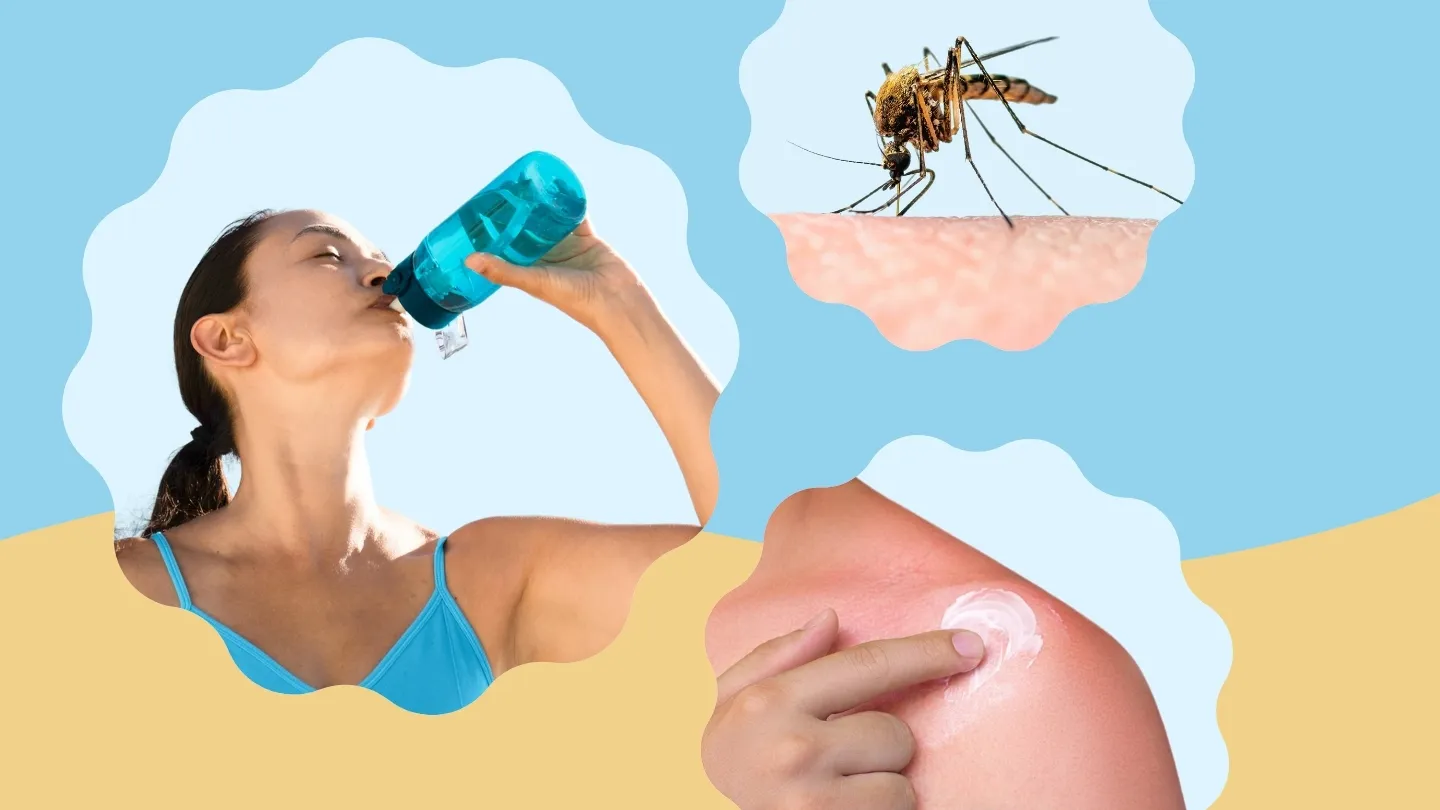Summer brings longer days, summer Fridays, and weekend getaways. It’s important to keep in mind, however, that the very things that can make summer joyful and relaxing — sun, water, and outdoor activities — can also present health hazards.
“That whole ‘school’s out’ mentality continues through adulthood, with people more likely to cut corners when it comes to health during the summertime,” says Nitin A. Kapur, MD, MPH, a primary care physician with Cedars-Sinai Medical Network in Santa Monica, California. “It’s still important for people to be conscientious and aware,” he adds, even when fun is the season’s top priority.
Here, experts share the most common summertime health hazards and how to prevent them, so you can stay safe and healthy all summer long.
1. Heatstroke and Heat Exhaustion
When temperatures reach sweltering levels, it’s not just uncomfortable — it’s also dangerous and potentially deadly.
How to Prevent Heat-Related Illness
Kim Knowlton, PhD, an assistant professor of environmental health sciences at Columbia University in New York City, advises people to slow down and adjust their work and activity schedules to keep cool during midday, when the sun tends to be the strongest.
If you don’t have access to AC, ask your local health department about heat-relief options in your area, or check your state’s department of health website to find a nearby cooling center, which is a designated building that offers relief from the heat.
Above all, be on guard, says Knowlton, who studies the impacts of climate change on public health. “If you start feeling sick, take the heat seriously.”
- A body temperature of 103 degrees F or higher
- Hot, red, dry, or damp skin
- A fast pulse
- Headache or dizziness
- Confusion
- Irritability
- Slurred speech
- Loss of consciousness
- Heavy sweating
- Cold, pale, clammy skin
- Nausea or vomiting
- Muscle cramps
2. Dehydration
How to Prevent Dehydration
If you have kidney or heart problems, talk to your clinician about what amount of water is right for you.
3. Sunburn and Sun Damage
How to Prevent Sun Damage
Apply sunscreen to areas that are commonly overlooked, such as the scalp, ears, front and back of the neck, chest, backs of knees, and tops of feet, says Natasha Mesinkovska, MD, the vice chair of clinical research for the department of dermatology at the School of Medicine at the University of California at Irvine. Once you’ve properly applied sunscreen, don’t forget to wear sunglasses. They’re for more than style: UVA and UVB rays can also damage eyes. For even more protection, add a sun hat and wear clothing that’s specifically designed to protect skin from strong sun.
4. Drowning
How to Prevent Drowning
The following measures can prevent a child from drowning.
- Swim in designated areas supervised by lifeguards.
- Swim with a buddy; do not allow anyone to swim alone.
- Don’t leave young children unattended or without adult supervision near water.
- Avoid distractions when supervising children around water. (Consider appointing a “water watcher,” whose only responsibility is to keep an eye on children while swimming.)
- Have children or inexperienced swimmers wear life jackets — not water wings or inflatable toys — but do not solely rely on them.
- If a child is missing, check the water first. Every second is important in preventing death or disability.
- Secure home pools with barriers to the water when not in use.
- Store water safety equipment, life jackets, and a first-aid kit near home pools.
Additionally, if you find yourself predisposed to swimmer’s ear (an infection of the outer canal of the ear), try wearing earplugs when taking a dip, suggests Kapur.
5. Insect Bites
How to Prevent Bug Bites
6. Allergies and Poison Ivy
We typically think of spring as allergy season, but rising temperatures and longer-lasting warm seasons increase pollen production and are extending allergy season, according to Knowlton. Pollen settling onto surfaces we touch, like picnic blankets or patio furniture, can also set off an allergic skin reaction, or contact dermatitis, says Kapur.
How to Prevent Allergic Reactions
To keep your home pollen-free, Knowlton suggests using a damp cloth to remove pollen from hair and skin or showering right after coming in from the outdoors, as well as washing outdoor clothes and bedding to remove pollen that has settled there, and vacuuming regularly. For poison ivy, wearing long pants and long sleeves when hiking or entering an area where the plant might be present is the best way to avoid this troublesome summertime rash.
7. Spoiled or Undercooked Food
Who doesn’t love dining alfresco? Whether you’re grilling or picnicking, though, take a second to consider how long your feast has been sitting out unrefrigerated, or if what’s hot off the grill is truly cooked through. “We forget that dishes with mayo need to be refrigerated, or not to let food sit in the car or outside in the sun,” says Kapur, who has seen plenty of picnickers come in for gastrointestinal complaints such as nausea, vomiting, and diarrhea.
How to Prevent Food-Related Illnesses
You can also separate beverage and food coolers to limit the number of times you need to open the food cooler, which will help keep the food colder for longer. Make sure to close coolers tightly after opening.
8. Sexually Transmitted Infections
How to Prevent STIs
- Use protection. With the 2022 release of FDA-cleared underwear designed for oral sex and condoms created for anal sex, in addition to latex male condoms, female condoms, dental dams, and latex or nitrile gloves, there are more kinds of protective barriers available than ever before. If used correctly and consistently, barriers can reduce your risk of chlamydia, gonorrhea, syphilis, and other STIs.
- Get tested. Before getting physical with a new partner, confirm that you each have a clean bill of health by getting an STI test, since many STIs show no symptoms. Planned Parenthood offers a location-based search function on their website to help you locate care.
- Avoid exchanging sexual fluids. There are plenty of pleasurable sexual activities that don’t involve penetration. To lower your risk of STIs, consider putting mutual masturbation, massages, or sex toys into your summer of love rotation.
9. Injuries to Bare Feet
Feeling the grass between your toes or walking barefoot on the beach is a summer treat, but going shoeless can expose your feet to a host of injuries. You can get a puncture wound if you step on something sharp like glass, nails, or even seashells. Walking barefoot on a hot surface can cause burns, and walking barefoot on a damp surface exposes the feet to fungal infections like ringworm and athlete’s foot. And for those tempted to run a lawnmower barefoot, know that mechanical accidents can cause major damage.
How to Prevent Foot Injuries
- Sandals are good in locker rooms, at the pool, and even in hotel rooms. They help limit the likelihood of contracting a fungal infection like athlete’s foot or a viral infection like plantar warts. Look for a pair that’s received the APMA Seal of Acceptance, don’t rewear them year after year, and avoid walking long distances in them.
- Use water shoes or sneakers at the beach, lake, or river — and for other types of outdoor recreation. Just be sure they are completely dry before you put them back on again next time.
- For hiking, wear hiking boots or shoes. The sturdy soles of hiking footwear will protect your feet from rocks underfoot and give you traction on slippery surfaces, and the thick material of the boot or shoe will protect your foot from thorns, prickers, and ticks and insects.
- Wear sneakers or work boots during yardwork. This is especially important when using a lawnmower.
The Takeaway
- Even though summer is often a relaxing and carefree time of year, it’s important to be aware of summer-specific hazards like strong sun, insect bites, and drowning.
- Proper use of sunscreen and sunglasses can help prevent skin cancer.
- Use insect repellent and check your body carefully after hiking and other outdoor activities to prevent illnesses caused by ticks and insect bites.
- Avoid going barefoot to prevent puncture wounds and other foot injuries.
Additional reporting by Claire Young.
Read the full article here




